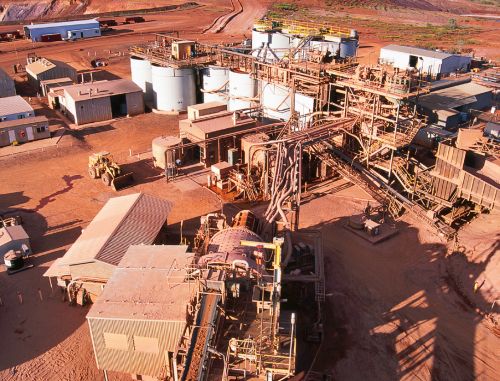Introduction
Knowing the mineralogical composition of ore is critical to pre-planning and optimizing processing operations and controlling costs associated with energy and chemical use. Identifying the mineral makeup of the incoming ore bearing rocks is beneficial for many reasons that can vary depending on commodity and location, including:
- Track changes in alteration to direct oxides to leach pads and sulfides to flotation circuits
- Monitor quartz content in ore to optimize crusher power consumption based on hardness
- Quantify talc and CaCO3 to predict acid consumption, monitor chemical usage and improve process economics
- Monitor clay and calcite content to assess permeability and predict percolation through leach pads
Olympus X-ray Diffraction
Olympus has answered the need for rapid mineral identification and quantification for geometallurgical applications with the development of two innovative XRD analyzers: the field portable TERRA and the benchtop BTX II.These instruments allow operators to rapidly measure phases of importance in minerals processing, pyrometallurgical processes, and in ores. The mineralogical information provided by these instruments help to optimize process strategies that can save companies time and money.
Olympus XRD analyzers use patented technology developed for the NASA Mars Rover program. They have been used to optimize mineral processing in Au, Ni, Fe Ore, Cu, coal, Al, U, and mineral sands operations by providing:
- Easy sample prep and fast analysis that can be operated by non-laboratory personnel
- On-site XRD analysis with comparable results to full-scale lab analyzers
- Qualitative XRF capability
- Affordable instruments with low cost of ownership
Case Study: Gold
Knowledge of the mineralogy of Au ores is important for optimization of the beneficiation process. Quantities of quartz, talc, calcite and calcium carbonate, fine and swelling clays, pyrrhotite, pyrite, graphite and other minerals can influence Au recoveries. Olympus XRD analyzers can quickly measure the presence and concentration of these minerals and allow mill managers to fine tune the system rapidly. At one U.S. gold mine in Nevada, a portable TERRA XRD analyzer has been used to assess the permeability and absorption of leach pad material. Low permeability and high absorption of leach liquor (characterized by high swelling clay content and low quartz content) halts percolation and results in slow and incomplete Au leaching. The TERRA was used to measure dry, powdered (<15mg of 120μm) leach pad samples and categorized them to define their likely leaching potential. Samples were easily and quickly grouped as Good, Fair, and Bad based predominantly on their relative clay and quartz content.
| Samples | ||||||
| Minerals | Bad 1 | Bad 5 | Fair 19 | Fair 21 | Good 4 | Good 5 |
| Quartz | 25.4 | 61.2 | 56.5 | 83.3 | 91.1 | 83.7 |
| Clays | 46.3 | 9.9 | 5.2 | 1.6 | n/a | n/a |
| Calcite | 3.0 | 16.9 | n/a | n/a | 8.9 | 2.6 |
| Muscovite | 3.2 | 6.0 | 5.6 | 8.3 | n/a | 8.2 |
| Other | 22.1 | 6.3 | 32.7 | 7.0 | n/a | 4.9 |
Case Study: Copper
XRD is commonly used to differentiate Cu oxide ore from Cu sulfide ore where these two are present in an ore body. This allows detailed and advanced notice of movement of oxides to the acid leach circuit and sulfides to the flotation circuit. Quantification of acid absorbing minerals in the leach circuit such as CaCO3 will influence the volumes of acid consumed and directly affect processing costs. In the floatation circuit, certain minerals can also float when concentrating Cu sulfide ore. This can reduce the grade significantly as they contaminate the final product. Knowledge of these gangue minerals allows the metallurgy manager to add reagents to help separate them from copper minerals. Olympus XRD analyzers provide advanced knowledge of the exact composition of the ore so operators can be proactive rather than reactive in their approach to reduce reagent use, streamline the process conditions and reduce costs.
Case Study: Iron
Banded iron deposits are typically made up of magnetite along with partially oxidized iron species such as goethite, limonite and hematite. All of these minerals are processed differently and have different value so it is important to identify the various species and separate them for processing. High-grade hematite requires only a simple crushing and screening process before being sold to a steel mill but magnetite needs secondary processing before it can be sold. Goethite and limonite are
usually not worth selling because they are very difficult to process and their residue can contaminate the machines.
The presence of magnetite can be determined by measuring the magnetism of the sample but this method is not quantitative and will not identify hematite or goethite. Some operations try to visually estimate the presence of hematite or magnetite, but that method is inexact and prone to error. Olympus XRD analyzers can easily identify and quantify the phases of high-grade and low-grade species as well as the gangue minerals in less than 5 minutes.
Conclusion
Understanding the mineralogy of ore has become more important for the processing plant as high grade ore reserves have become scarcer and plants now have to process low grade and complex ores. Economic pressures have put more emphasis on optimizing the process to maximize recovery and control costs. X-ray diffraction provides the mineralogical information of the ore necessary to optimize the operation. Olympus puts fast and accurate XRD analysis in the hands of the operator in small and easy to use instruments allowing critical process decisions to be made in real time.







